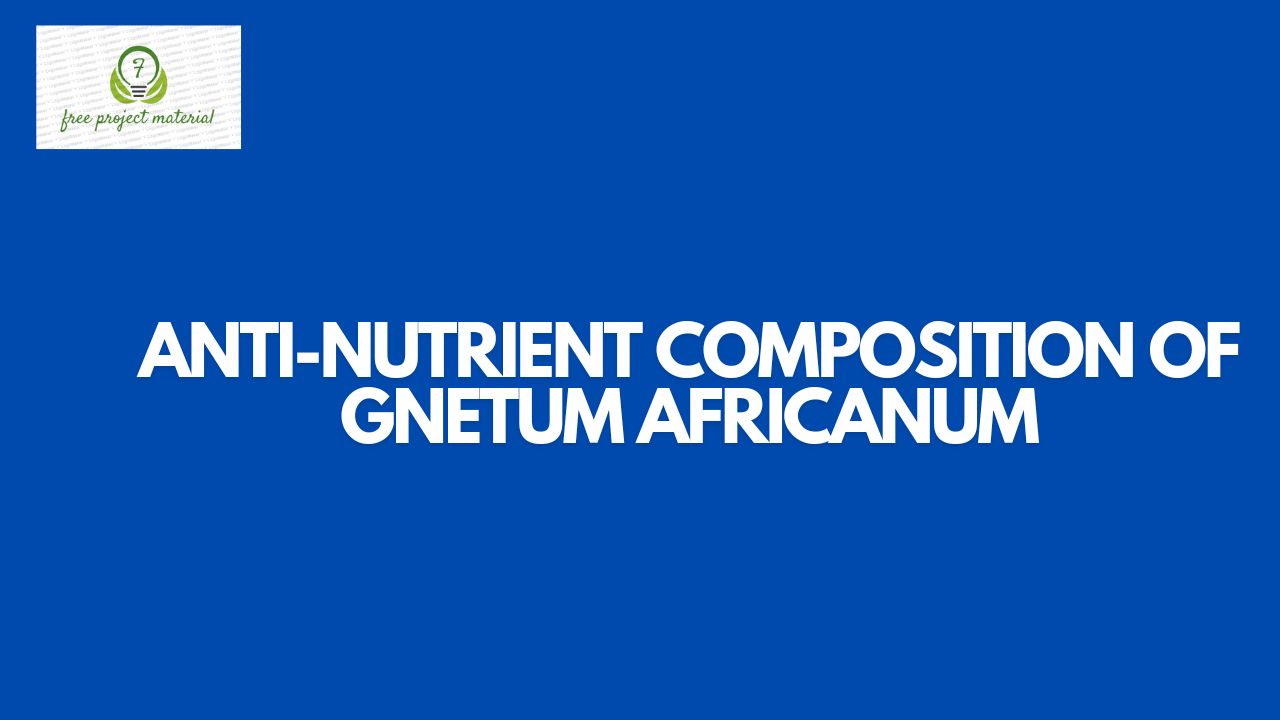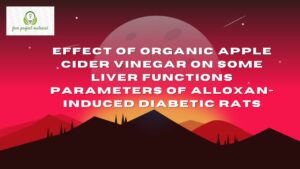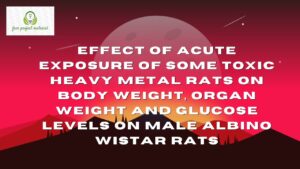ABSTRACT
The aim of this study was to determine the antinutrient composition of Ginetum africanum. Standard analytical methods were being employed in carrying out the analysis. The result of the study revealed the following: phytate (0.794 ± 0.099 mg/100g), tannins (1.042 ± 0.018 mg/100g), HCN (1.2105 ± 0.137) and Oxalate (3.361 ± 0.496 mg/100g). It was concluded that the level of oxalate, phytate, hydrogen cyanide and tannins values of Gnetum africanum is considered low and would be safe for animal and human consumption as most of these values are below the lethal dose. It is recommended that that proper food processing should be done to reduce these anti-nutrients for the benefit of consumers.
TABLE OF CONTENT
Title Page- – – – – – – – – i
Certification – – – – – – – ii
Dedication – – – – – – – – iii
Acknowledgements – – – – – – iv
Abstract – – – – – – – – v
Table of Content – – – – – – – vi
CHAPTER ONE: INTRODUCTION
1.1 Background of the Study – – – – – – 1-3
1.2 Aim and Objectives of the Study – – – – – 3
1.3 Scope and Limitation of the Study – – – – 4
1.4 Definition of Terms – – – – – – 4
CHAPTER TWO: LITERATURE REVIEW
2.1. Importance of Gnetum africanum – – – – 5-7
2.2 Chemical Composition of Gnetum africanum – – 7-8
2.2.1 Proteins – – – – – – – – – 8-9
2.2.2 Tannins – – – – – – – – 9-10
2.2.3 Minerals – – – – – – – – 10
2.3 Medicinal Importanc of Gnetum africanum – – – 10-13
2.4 Toxicity of Gnetum africanum – – – – – 14-16
2.5 Antinutrients – – – – – – – 16
2.5.1 Lectins – – – – – – – – – 16-18
2.5.2 Trypsin Inhibitors – – – – – – – 18
2.5.3 Phytates – – – – – – – – 18-19
2.5.4 Goitrogen – – – – – – – – 19-20
2.5.5 Oxalates – – – – – – – – 20-21
2.6 Antinutrient and Human Health – – – – 21-23
2.7 Method of Disabling Antinutrients in Plant Base Foods – 23-27
2.8 Hydrogen Cyanide (HCN) – – – – – 27
CHAPTER THREE: MATERIALS AND METHOD
3.1 Material – – – – – – – – 28
3.2 Method – – – – – – – – 28
3.2.1 Sample Collection – – – – – – – 28
3.2.2 Sample Preparation – – – – – – 28
3.2.2 Determination of Antinutrient – – – – – 29-31
CHAPTER FOUR: RESULT AND DISCUSSION
4.1 Result – – – – – – – – 32
4.2 Discussion – – – – – – – – 32-34
CHAPTER FIVE: CONCLUSION AND RECOMMENDATION
5.1 Conclusion – – – – – – – – 35
5.2 Recommendations – – – – – – – 36
References
CHAPTER ONE: INTRODUCTION
1.1 Background of the Study
Ginetum africanum and found that they have high content levels of vitamins and minerals including cystine, calcium, phosphorus, iron, magnesium, thianine, riboflavin, carotene, ascorbic acid and among other carotene content of vegetables is usually high during early growth period and declines rapidly with maturity (Ibrahim, 2005). Yet some vegetables are exception to that observation because they tend to retain carotene contents for long periods. Realizing the wide spread usuage of Gnetum Africana which are indigenous species in the Southern part of Nigeria. It become necessary to ascertain the contribution if these species to the wellbeing of the populace.
Ginetum africanum commonly known as Afang (Efik) Okazi (Igbo) Eru (Cameroun) grows naturally in humid forest is from the family Ginetacease. It is widely distributed in the forest zones Nigeria through Cameroun. Central African Republic and Gabon to Angola. Ginetum africana is a source of rapid incomes to farmers as buyers visit local villages in Akwa Ibom State and Cross River State on daily basis. The leaves are important ingredients in preparing tasty soup in many homes in the South-South and South East of Nigeria. In all traditional feasts or parties, afang soup is sure to be one of the main dishes of such occasions like traditional marriage, naming ceremony, burial and new yam festivals in Akwa Ibom State and Cross River State of Nigeria. Gnetum africana can be propagated through vines, seeds and roots. The common pests and disease are termite that attacks the stakes, mealy bugs that attack the leaves and wounds on the vine which may occur during harvest that exposes the plants to fungal attack.
Vegetables are known to be important sources of protective foods (Nnamami et al., 2009; Sheela et al, 2004) vegetables have also been reported to be good sources of oil, Carbohydrates, Minerals as well as vitamin (Adenipenkun and Oyetunji, 2010). The potassium content of leafy vegetables is good in the control of diuretic and hypertensive complications (George, 2003). George (2003) ascertained that the protein in vegetable are superior to those in fruits but inferior to those in grains vegetable fats and oils are known to lower blood lipids thereby reducing the occurrences of diseases associated with the damage of the coronary artery (Adenipenkun and Oyetunji, 2010). These vegetables however contain antinutritional factors that can affect the availability of the nutrients. Antinutritional factors is known to interfere with metabolic processes such that growth and bioavailability of nutrients are negatively influenced (Abara, 2003; Binta and Khetarpau, 1997) Phytate and oxalates have the ability to form chelates with di- and tri-valent metallic ions such as Cel, Mg, Zn and Fe to form poorly soluble compounds that are not readily absorbed from the gastrointestinal tract thus decreasing their bioavailability (Ademoroti, 1996). He further stated phytate inhibits the functions of some digestive enzymes. Lacleji et al. (2004) reported that oxalate causes irritation and swelling in the mouth and throat. High level of hydrogen cyanide has been implicated for cerebral damage and lethargy in man and animals (Ekop, 2007). The purpose of this study therefore is to evaluate the levels of antinutritional factors of Ginetum africana.
1.2 Aim and Objectives of the Study
The aim of this study is to determine the antinutrient composition of Ginetum africanum.
Objectives
The objectives of this study are:
- To determine the anti-nutrient composition of Ginetum africanum.
- To make useful recommendation base on the result of this study.
1.3 Scope and Limitation of the Study
This study will only cover both nutrient and antinutrient composition of Ginetum africanum. This is due to financial and time constraint.
1.4 Definition of Terms
Antinutrient: These are natural or synthetic compound that interfere with the absorption of nutrient.
Gnetum africanum (Afang) It is a vine likely originated from forest in Nigeria through Cameroon and Central African Republic belonging to the family of Gnetacea.



